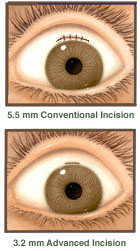Replacement Lenses - Foldable and
Non Foldable Intraocular Lens Implants (IOLs)
Once the cataract removal part of the procedure is completed, your doctor will have to replace your natural lens with a permanent, artificial lens called an Intraocular Lens, or IOL.
There are two types of IOLs available – nonfoldable and foldable. Nonfoldable lenses are made of PMMA, a hard plastic material first used in an IOL in 1949. Foldable lenses are made of diferent materials including silicone or acrylic.
 Small Incision Technique with Nonfoldable Intraocular Lens Implant (IOL) Small Incision Technique with Nonfoldable Intraocular Lens Implant (IOL)
Until recently, ophthalmologists were restricted as to
how small an incision they could create. This was due to the size of the non foldable intraocular lens implant. This type of incision is 5 - 7 mm and may require sutures for wound closure.
Small Incision Technique with
Foldable Intraocular Lens Implant (IOL)
With the advance of foldable IOLs, lenses can be implanted through the same small incision that is created in the phaco procedure. These IOLs are made of a flexible material allowing them to be folded for implantation.
A foldable IOL can be implanted through a smaller incision than the nonfoldable IOL. This type of incision is 2.8-3.5 mm and does not require sutures for wound closure. Once inside the eye, the lens unfolds and returns to its original shape.
Benefits of a smaller incision include:
- less trauma to the eye
- little discomfort during or after the surgery
- often do not require stitches
- can aid in reducing astigmatism and provide better vision
- will usually provide a faster postoperative recovery period and quicker return to normal activity
 Your doctor's selection of the foldable lens may be based on his/her professional observations of cases where an intraocular lens (IOL) provides excellent visual results, and shows a delay or resistance to the growth of a secondary cataract or capsular clouding (opacification). Your doctor's selection of the foldable lens may be based on his/her professional observations of cases where an intraocular lens (IOL) provides excellent visual results, and shows a delay or resistance to the growth of a secondary cataract or capsular clouding (opacification).
Following surgery, you will need to visit your eye doctor for several months. You may also need to use eye drops daily. With an intraocular lens implant, you can expect improved vision within a few days following the surgery. Recovery time depends upon the underlying health of the eye, the ease of the surgery, and the technique and IOL which has been selected by you and your doctor.
Your best final vision will be achieved after full healing has occurred and new glasses have been prescribed. This is usually not until at least six weeks after your surgery.
|